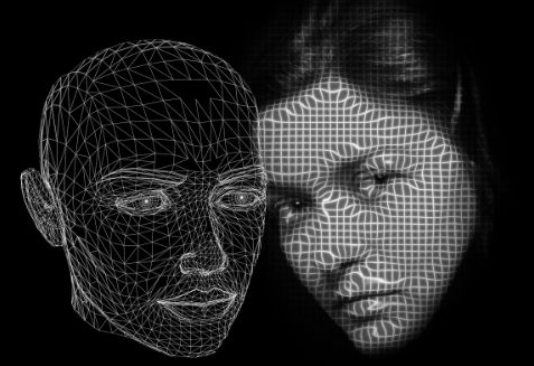
- I’m excited to take you on a journey through the captivating worlds of cinema and technology.
Strap in as we dive deep into the themes of identity, technology, and consciousness portrayed in three groundbreaking films: “2001: A Space Odyssey,” “Her” and “The Ghost in the Shell”.
- As a movie buff interested in the intersection of film and technology, I embarked on this exploration with an open mind and a thirst for knowledge.
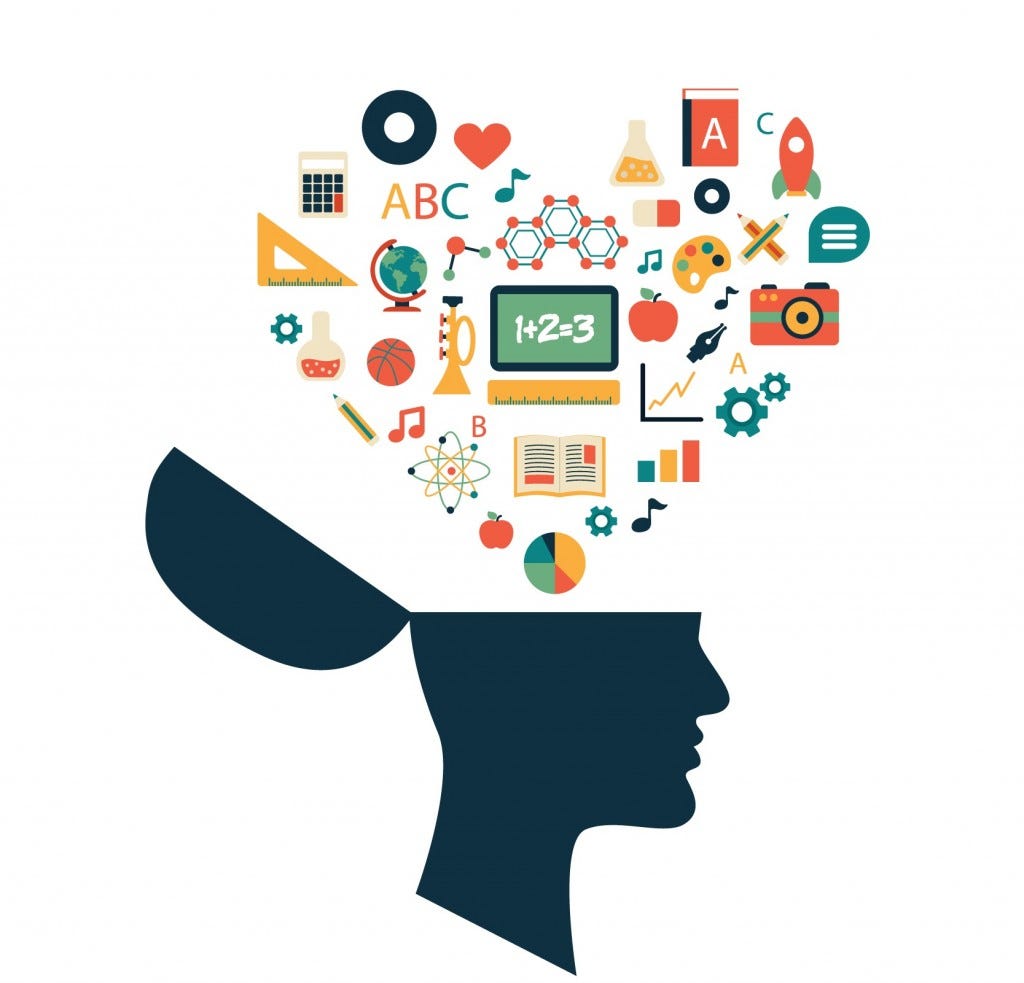
These movies serve as significant reflection of contemporary debates surrounding the evolving relationship between humans and technology, particularly within the realms of artificial intelligence, consciousness, and the increasingly blurred boundaries of identity.
We can further see proof of this when we dive deep into each realm set in the movies…
In “Her,” the profound portrayal of an intimate bond between a human and an AI system challenges conventional notions of companionship, prompting introspection on the authenticity of emotions in human-computer interactions.

Being in a “human” relationship, we tend to be more observant of the dynamics that define it. Most individuals who choose to have a partner are involved in a dyadic relationship, and are acquitted to interactions and connections between two individuals, encompassing various aspects such as communication patterns, emotional bonds, and shared experiences (Fessler, 2003). Despite Samantha being an artificial intelligence, the film depicts her as possessing human-like emotions and desires, allowing her to form a genuine emotional connection with the protagonist, Theodore. This portrayal highlights the complexities of human-AI relationships and raises thought-provoking questions about the nature of consciousness and the potential for emotional authenticity in technologically mediated interactions.

Similarly, “2001: A Space Odyssey” delves into the emergence of artificial intelligence, prompting consideration of the ethical consequences of bringing forth sentient beings. The character of HAL 9000, an advanced AI system, exhibits human-like attributes such as intelligence, self-awareness, and even emotional responses. HAL’s malfunction and subsequent actions throughout the film prompt viewers to ponder the implications of creating intelligent machines and the ethical responsibilities associated with their development and control. In this day and age, this is now what we call Siri, or Alexa who maintains voice profiles for all users and provides personalised services.
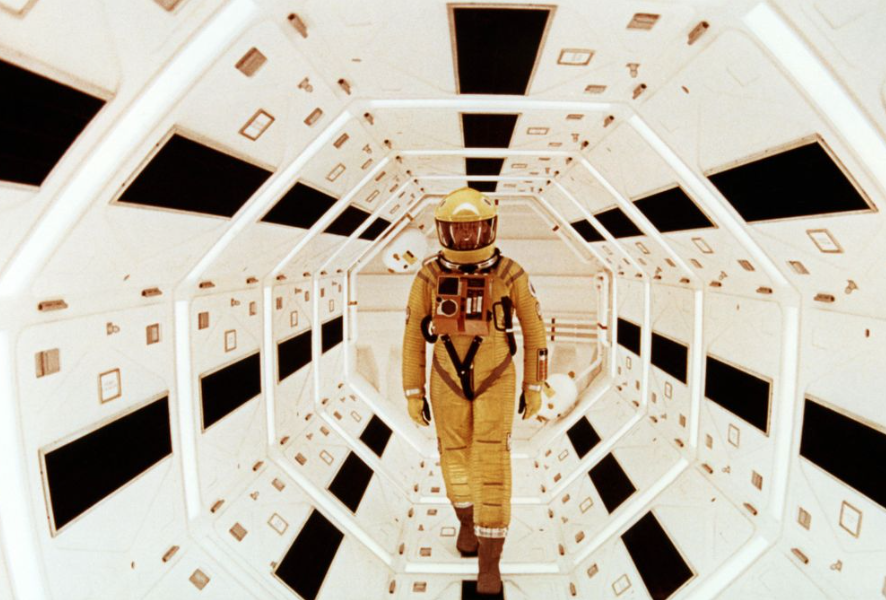
Meanwhile, “Ghost in the Shell” explores the fusion of human behaviour in contrast with technology, questioning the core of selfhood and the transformative impact of cybernetic enhancement. Major Motoko Kusanagi, is depicted as a cyborg that blurs the line between human and machine. Despite her remarkable abilities, she grapples with feelings of disconnection and existential angst, highlighting the challenges that are built from merging human abilities with technological augmentation. Today we call those feelings “depression” and “anxiety”, and One in five Australians experience mental illness every year, and 45% of Australian adults will be affected by mental illness at some time in their life (Services n.d.).

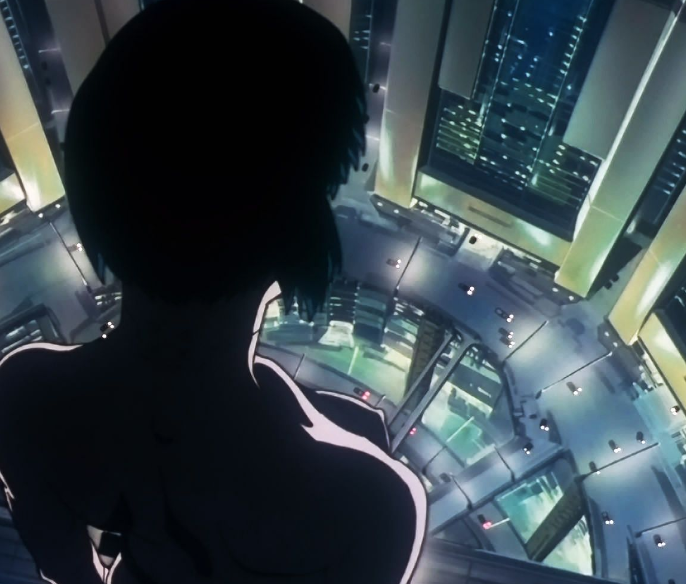
Optimising the interplay between people, the environment, and technology can significantly enhance people’s quality of life (van Hoof et al. 2019). These movies serve as significant reflections of contemporary debates surrounding the evolving relationship between humans and technology, particularly within the realms of artificial intelligence, consciousness, and the distinctive blurred boundaries of identity.
These films offer compelling narratives that prompt audiences to reconsider their relationship with technology and envision the future of humanity in an increasingly interconnected world. By exploring these specific themes they challenge our perceptions and provoke critical reflection on the implications of technological advancement for the human experience. Through these thought-provoking narratives, audiences are invited to explore the complexities of human-AI relationships, the ethical dilemmas of AI development, and the existential questions raised by the fusion of human consciousness with technology.
Below you can see the interactions from the live analysis from discord.
- HER

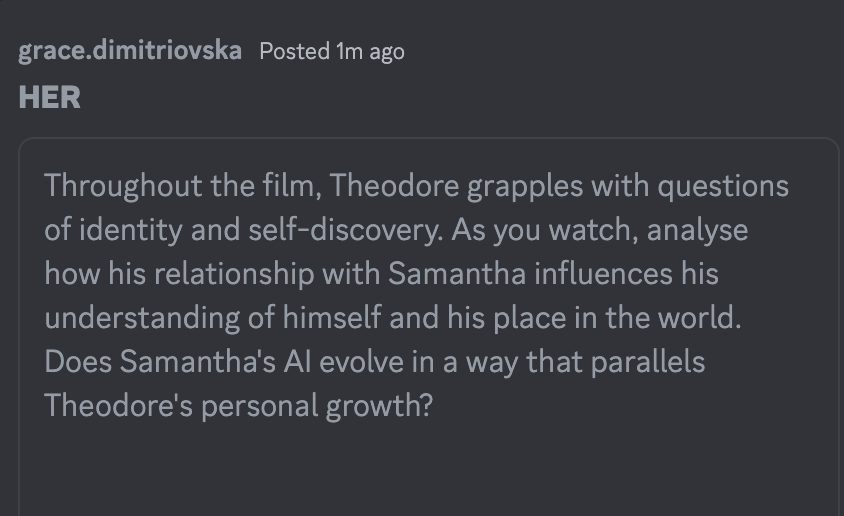
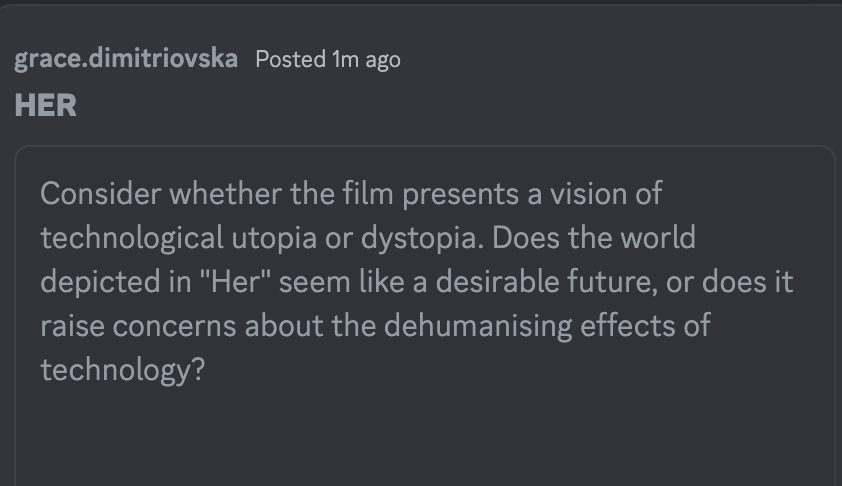
- 2001: A SPACE ODYSSEY
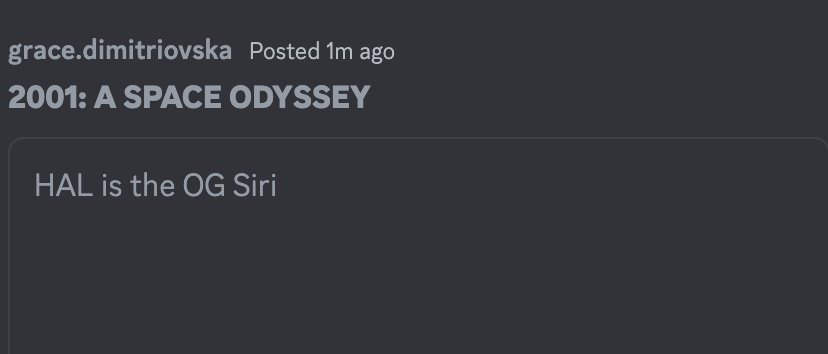


- GHOST IN THE SHELL

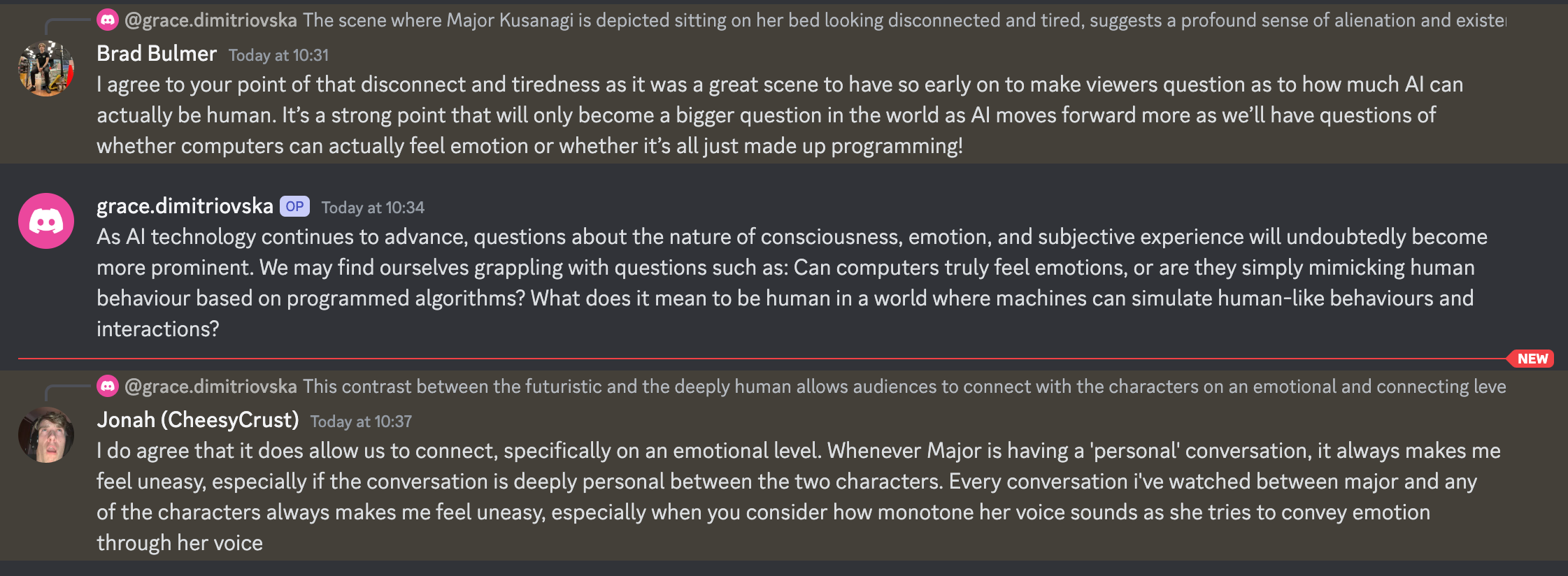
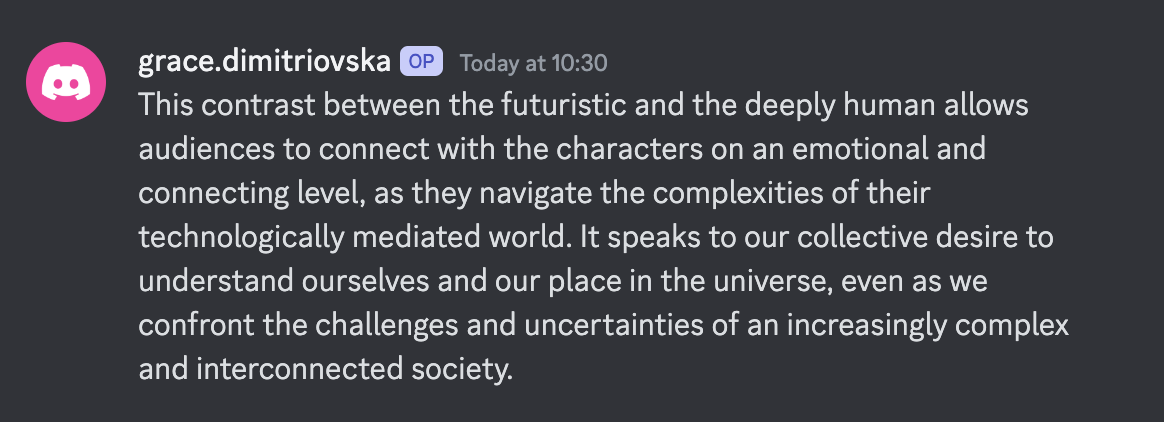
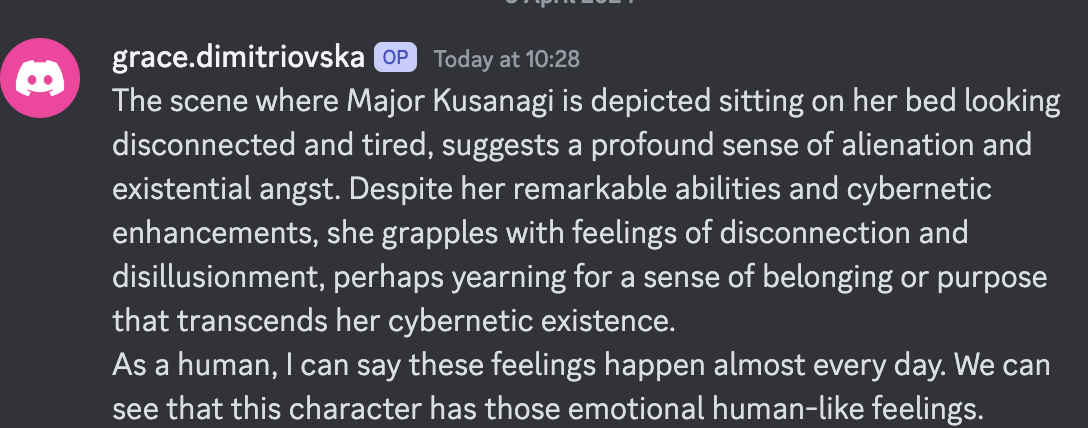
- REFLECTION
One of the most enlightening aspects of my research was uncovering the real-world implications of technological advancement. From data privacy concerns to the digital divide, I realised the importance of considering the socio-political dimensions of technology in our rapidly evolving world.
As I continue to navigate the ever-changing landscape of film and technology, I’m excited to further my understanding and contribute to meaningful discourse on these pressing issues.
So there you have it, folks – a blogger’s reflective journey through the worlds of cinema and technology. I hope you enjoyed the ride as much as I did, and I can’t wait to embark on our next adventure together.
- REFERENCES
Fessler, Daniel MT, and Kevin J. Haley. “The strategy of affect: Emotions in human cooperation.” (2003).
Services, D of H & H n.d., Mental illness statistics, http://www.betterhealth.vic.gov.au.
van Hoof, J.; Beneken genaamd Kolmer, D.M.; de Vlugt, E.; de Vries, S.I. Quality of Life: The Interplay between Human Behaviour, Technology and the Environment. Int. J. Environ. Res. Public Health 2019, 16, 5106. https://doi.org/10.3390/ijerph16245106

Leave a comment